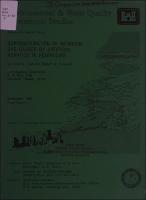Please use this identifier to cite or link to this item:
https://hdl.handle.net/11681/4542Full metadata record
| DC Field | Value | Language |
|---|---|---|
| dc.contributor | Limnological Associates | - |
| dc.contributor | Hydraulics Laboratory (U.S.) | - |
| dc.contributor | Environmental and Water Quality Operational Studies (U.S.) | - |
| dc.contributor.author | Fast, Arlo Wade | - |
| dc.contributor.author | Hulquist, Robert G. | - |
| dc.date.accessioned | 2016-03-16T22:10:00Z | - |
| dc.date.available | 2016-03-16T22:10:00Z | - |
| dc.date.issued | 1982-09 | - |
| dc.identifier.uri | http://hdl.handle.net/11681/4542 | - |
| dc.description | Technical Report | - |
| dc.description | Abstract: Dissolved nitrogen gas (N₂) contents of 12 southern California reservoirs were assessed during the summer of 1979. Eleven of the reservoirs were artificially destratified by compressed air injection at depths, while one reservoir was not artificially aerated. Destratification ranged from nearly complete to quite incomplete. The artificially aerated reservoirs could be categorized into four types of conditions based on their degrees of destratification and their dissolved N₂profiles. (A.) Type I reservoir conditions were characterized by nearly uniform oxygen and temperature conditions at all depths and N₂saturations between 100 and 110 percent. (B.) In Type II reservoirs, the air diffuser was not placed at the deepest depth. Consequently, a thorough mix occurred above the diffuser resulting in N₂saturations which were 100 to 110 percent; however, strong thermal and chemical stratification persisted below the diffuser where N₂saturations could exceed 140 percent. (C.) Type III reservoir conditions occurred when insufficient air was injected to cause a thorough mix; consequently, there was a shallow thermocline near the lake's surface below which were uniform temperatures. Under Type III conditions, N₂saturations saturations normally ranged from 106 to 120 percent below the thermocline. (D.) Type IV reservoirs had a combination of Type II and III conditions where the air diffuser was placed above the bottom and insufficient air was injected to cause a thorough mix above the diffuser depth. Under Type IV conditions N₂saturations also represented a combination of Type II and III conditions. With all types, N₂saturations often increased even though absolute N₂concentrations decreased. This was caused by an incomplete degassing of the deep waters as it was warmed during destratification. Although there is a general relationship between the types of conditions and N₂saturations, there are no general procedures for predicting N₂saturations. | - |
| dc.publisher | Environmental Laboratory (U.S.) | - |
| dc.publisher | Engineer Research and Development Center (U.S.) | - |
| dc.relation | http://acwc.sdp.sirsi.net/client/en_US/search/asset/1040340 | - |
| dc.rights | Approved for public release; distribution is unlimited. | - |
| dc.source | This Digital Resource was created from scans of the Print Resource | - |
| dc.subject | Aeration | - |
| dc.subject | Nitrogen | - |
| dc.subject | Reservoir stratification | - |
| dc.subject | Reservoirs | - |
| dc.subject | Nitrogen supersaturation | - |
| dc.subject | Nitrogen content | - |
| dc.subject | Water quality | - |
| dc.title | Supersaturation of nitrogen gas caused by artificial aeration in reservoirs | - |
| dc.type | Report | en_US |
| Appears in Collections: | Technical Report | |
Files in This Item:
| File | Description | Size | Format | |
|---|---|---|---|---|
| TR-E-82-9.pdf | 19.61 MB | Adobe PDF |  View/Open |